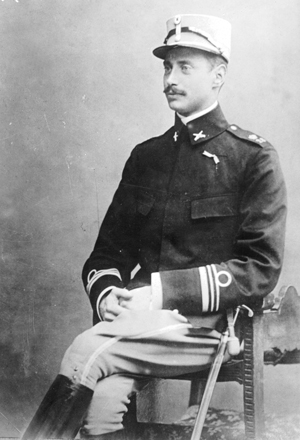By Rabbi Dr. Michael Leo Samuel


CHULA VISTA, California — My friend and editor of San Diego Jewish World, Don Harrison, and I were having an interesting conversation I would like to share with you. We were talking about the famous Danish King Christian X, who was said to have worn a yellow Star of David together with his people to show solidarity with the Danish Jews. The yellow Star of David helped the Nazis distinguish the Jews from the Gentiles.[1]
The story gained considerable currency with the publication of Exodus by the novelist Leon Uris, but the story was not a true one.[2] In fact, through most of the German occupation, Denmark’s government was permitted to run the country’s internal affairs. Although the Germans suggested that anti-Jewish measures be enacted by the Danes—including a requirement that Jews wear the yellow stars—the Danes steadfastly refused. Therefore, Danish Jews never wore the yellow star and there was never any reason for Christian X to do so either.[3]
To my surprise, I must confess I was unaware that the story recorded by Uris was only a legend. I admitted Don was correct, but my studies in myth has taught me we must always bear in mind that there is more to a story than meets the eye.
Believe it or not, sometimes myths—regardless of how strange they may seem—often have elements that are grounded in historical fact. Bo Lidegaard is a Danish historian, who wrote, Countrymen: The untold story of how Denmark’s Jews escaped the Nazis, of the courage of their fellow Danes—and of the extraordinary role of the SS. At the very beginning of the book, he shows a political Danish cartoon that appeared in one of the Göteborg Trade and Maritime Journal newspapers in April of 1940 depicting how King Christian rode through the streets of Copenhagen wearing the yellow star in defiance of Nazi demands that the Jews do so.
According to Lidegaard, the controversial cartoon depicts:
-
- . . . the Danish prime minister, Thorvald Stauning, in an overcoat, in thoughtful conversation with King Christian, easily recognizable by his riding boots and uniform. In the caption, Stauning asks: “What shall we do, Your Majesty, if Scavenius says that our Jews also have to wear yellow stars?” The king replies: “Then we’ll probably all wear yellow stars”—an almost literal transcription of an interview King Christian had had with Acting Prime Minister Vilhelm Buhl four months earlier. The fact that the tenacious myth is rooted in a real conversation has only been revealed recently, as the handwritten diary notes made by the king were made accessible to historians. Even if King Christian was prepared to do so, he did not ride through the streets of Copenhagen wearing the yellow star; in fact, no one in Denmark was required to wear it.[4
What is remarkable is the fact that the King was willing to do so in the event the Nazis tried to force their will upon the Danish people. But the Nazis did not even try to make the Jewish badge obligatory in Denmark, due to the Danes’ strong opposition to anti-Jewish measures. Again, let us reiterate, though the story is fictional, it powerfully demonstrates the Danish king’s courage and commitment to his country’s Jews.
The question raised between these two men was of real concern—especially since the United States did not yet enter the war. The discussion of the plight of the Danish Jews was a sensitive one for everyone involved. But in the end, as Don also pointed out in his article, “Considering the inhuman treatment of the Jews not only in Germany but also in other countries under German occupation, one could not help but worry that one day this request would also be presented to us,” Lidegaard wrote. “If so, we would have to reject it outright following their protection under the Constitution. King Christian, his assistants, and the Danish people stood up for the constitutional rights of the Jewish Danes, and Hitler fortunately relented.”
As I read Lidegaard’s account of what actually occurred, I thought of a conversation Socrates had where he introduced the concept of the “noble lie.” For those unfamiliar with this concept, the noble lie presents to the public false propaganda for the sake of the public welfare.[5] Lidegaard explains how the cartoon and myth of the King served an important political purpose;
- Buhl did not keep the king’s suggestion to himself, and four months later the conversation appeared as the text of a cartoon in a newspaper in neighboring Sweden, also neutral but not occupied by the Germans. The cartoon gave birth to the compelling image of King Christian riding the streets of occupied Copenhagen wearing the yellow star. The myth has never died, and new generations have taken it as a token of hope amid the dismal history of the Holocaust.
The history from the Swedish cartoon traveled widely and it proved both compelling and useful. It served those in the United States and the United Kingdom who were working to improve the public image of an occupied Denmark criticized for its cowardly appeasement of Hitler’s Germany. In the United States, the myth was spread by Danish-American and Jewish organizations, in the United Kingdom by the Political Warfare Executive as part of a targeted effort to drive a wedge between Denmark’s allegedly pro-German government and the resistance-willing people rallying behind their king. (Ibid.).
Apparently, King Christian X did not mind allowing this story to be disseminated. And although he wrote about his conversation in his personal diary, to date (based on my research), King Christian’s diary has never been published or translated. This is a shame, for such a book records one of the most important chapters of Holocaust history.
As it turned out, the cartoon and the story associated with it spread across the world, and it served to bolster the public image of Denmark and their willingness to protect the Jews as a matter of principle and conscience. In the end, Plato and Socrates proved correct about the role of the “noble lie” in shaping a country’s political values. In addition, it illustrates how this conversation between King Christian X and PM Buhl took on a new life beyond what actually occurred.
There is a significant addendum I would like to add to this article concerning the yellow Star of David.
When the Nazis decreed that the Jews be forced to wear the yellow star on their clothing, almost all the Polish Jews cooperated with the law, in fear of severe punishment; however, diaries from the time speak with unabashed bitterness about having to wear the badge. According to the Shoah Resource Center of the yaadvashem.org, many French Jews refused to wear the badge, and some French non-Jews expressed their empathy for the Jewish plight by wearing stars themselves. Even the French police did not enforce the decree. In Holland, an underground newspaper expressed its solidarity with the Jews by printing 300,000 stars, inscribed with the words, “Jews and non-Jews are one and the same.”[6]
I want to thank Don Harrison for schooling me about this remarkable story, but after everything is said and done, the truth is often more polyvalent than most of us imagine possible.
NOTES
[1] Don’s information fascinated me for I remember as a young teen reading the Danish Lutheran pastor named Poul Borchsenius, who wrote a fascinating short History of the Jews that left a deep impression on me. In his fourth volume, the author made mention of this story. As a side note, Borchsenius was a hero in his own right, as were so many of the people who defied the Nazis in Denmark, as Don Harrison finely described in his various articles. Borchsenius was known by the Nazis as “the shooting priest” because he blew up railroad lines connecting Germany and Norway. Thanks to him, all the twenty or so Jews of Randers, mostly doctors and civil servants, were safely transported to Sweden in 1943. At the end of 1943, when the Germans almost captured Borchsenius’s, the Danish underground sent him and his family to safety in Sweden, where he lived with refugee Danish Jews until the end of the war. Later he visited Israel: his Protestant associations with the Holy Land were overlaid with fresh images of Israelis reconquering the desert. His disparate experiences with Jews before, during, and after the war must have intrigued him, and he plunged into a reading of Jewish history. And that his how he came to write the series of books that I will never forget. For more information see, https://www.commentarymagazine.com/articles/lucy-dawidowicz/the-history-of-the-jews-by-poul-borchsenius/
[2] In the interest of clarity, here is the passage Don alluded to from Uris’ Exodus, “The King has said that one Dane is exactly the same as the next Dane. He himself will wear the first Star of David and he expects that every loyal Dane will do the same.” The next day in Copenhagen almost the entire population wore armbands showing a Star of David. The following day the Germans rescinded the order” Leon Uris, Exodus (New York: Bantam Books, 1958), p. 72.
[3] Here are the excellent articles Don Harrison wrote concerning the legend of King Christian X of Denmark: http://www.sandiegojewishworld.com/denmark/copenhagen/1994-01-28_myth_magic.htm
http://www.sandiegojewishworld.com/denmark/copenhagen/1994-02-04_jews-danes_400_years.htm
http://www.sandiegojewishworld.com/denmark/copenhagen/1994-01-28_why_danes_rescued.htm
http://www.sandiegojewishworld.com/denmark/copenhagen/1994-01-14_red_cap_girl.htm
[4] Bo Lidegaard and Robert Maass (Trans), Countrymen: The untold story of how Denmark’s Jews escaped the Nazis, of the courage of their fellow Danes—and of the extraordinary role of the SS (New York: Alfred Knoph, 2013), pp. 8-9.
[5] Plato, Republic 607a, comp. 611b-612a.
[6] https://www.yadvashem.org/odot_pdf/Microsoft%20Word%2
*
Rabbi Dr. Michael Leo Samuel is spiritual leader of Temple Beth Shalom in Chula Vista. He may be contacted via michael.samuel@sdjewishworld.com
My favorite quote from the western “Who Killed Liberty Valance”….is: ….
”When the legend becomes fact, print the legend.”
Pingback: The noble lie: King Christian X and the Jews - San Diego Jewish World - LEO Token Charts